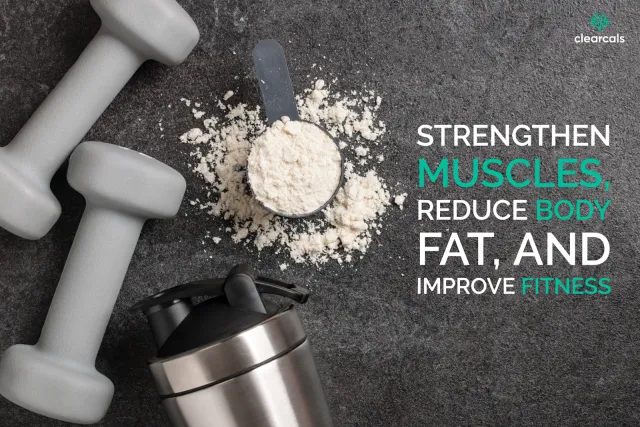Looking for a Personalized Diet Plan?
Gulab Jamun Calories, Nutrition, and Health Benefits

Gulab Jamun, a quintessential Indian dessert, is as rich in taste as it is in calories.
While the occasional indulgence is hard to resist, it's important to understand the nutritional value and the impact it can have on your health goals.
Whether you're counting calories for weight loss or managing sugar intake for conditions like diabetes, tracking what you eat is crucial.
Let's dive into the calorie count and nutritional information of Gulab Jamun and other popular Indian sweets, and discover how the Hint app can help you stay on top of your nutrition effortlessly.
TL;DR
- One small piece of gulab jamun has 97 kcal.
- The calorie count varies based on the serving size.
- Consuming sweets in moderation is key due to high sugar and fat content.
- Indian sweets often contain more essential nutrients than biscuits or chocolates.
How Many Calories Are In One Gulab Jamun?
The calories in Gulab Jamun vary depending on its size and the recipe used. A small piece (30 grams) has 97 kcal, but as the serving size increases, so does the calorie count.
Tracking your intake is important, and you can do this easily using the Hint app, which allows you to monitor your food consumption with precision.
| Gulab jamun Size (in grams) | Calories (kcal) | |||
|---|---|---|---|---|
| 1 Gulab Jamun | 2 Gulab Jamun | 3 Gulab Jamun | 4 Gulab Jamun | |
| 1 Small piece (30 grams) | 97 | 193 | 290 | 387 |
| 1 Medium piece (40 grams) | 129 | 258 | 387 | 516 |
| 1 Large piece (50 grams) | 161 | 322 | 483 | 644 |
Hint Pro users can further personalize their calorie and macronutrient goals, while Hint Premium offers insights from experienced dietitians and suggestions for balanced indulgences.
You can keep an eye on your sugar intake with features like Instant Diet Plans and Personalized Health Goals.
Watch: How to Track Gulab Jamun Calories on the Hint App
Gulab Jamun Nutrition
Gulab Jamun is rich in carbohydrates (35%), moderate in protein (11%), and high in fat (54%). It’s also a source of essential nutrients like selenium and biotin. However, due to its sugar and fat content, moderation is advised.
Using the Hint app, you can track your consumption of not only calories but also macronutrients, helping you make more informed choices.
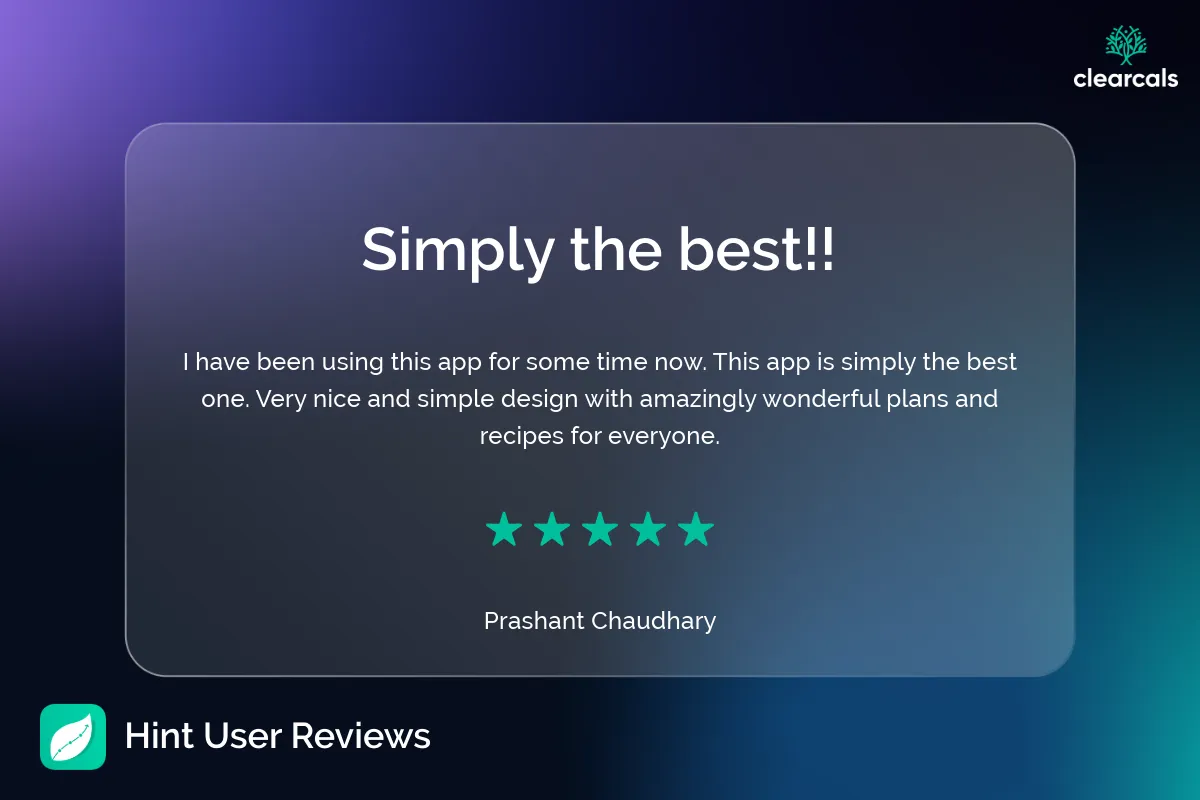
Popular Indian sweets
Many Indian sweets share a common trait—deliciousness! However, they also tend to be calorie-dense, making it crucial to balance indulgence with awareness.
Here’s a breakdown of some favorites, along with how the Hint app can help you monitor your intake.
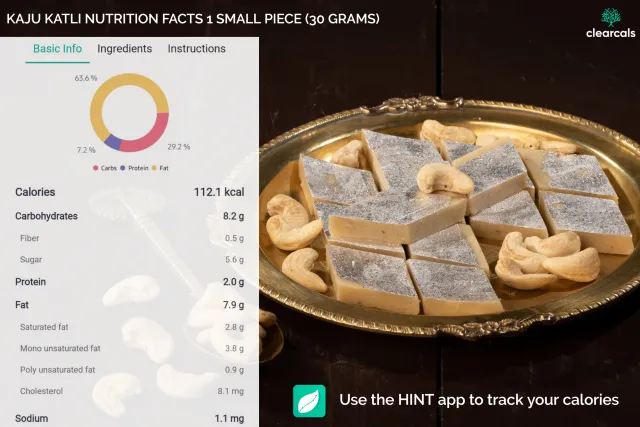
1. Kaju Katli Calories
One small piece (30 grams) of Kaju katli or Kaju barfi has 112 kcal. 29% of these calories are from carbohydrates, 7% from protein, and 64% from fat. Whereas 100 grams of Kaju katli has 370 kcal. Eat this in moderation as it is high in calories, sugar, and saturated fats.
If you're craving Kaju Katli but want to stay within your calorie goals, tracking it through the Hint app is a great way to stay on course.
Calories in Kaju katli depend on their serving size or quantity in grams and recipe. Here is a table of how calories increase with the serving size of Kaju katli.
| Kaju Katli Size (in grams) | Calories (kcal) | |||
|---|---|---|---|---|
| 1 Kaju Katli | 2 Kaju Katli | 3 Kaju Katli | 4 Kaju Katli | |
| 1 Small piece (30 grams) | 112 | 224 | 336 | 448 |
| 1 Medium piece (40 grams) | 150 | 300 | 450 | 600 |
| 1 Large piece (50 grams) | 187 | 374 | 561 | 748 |
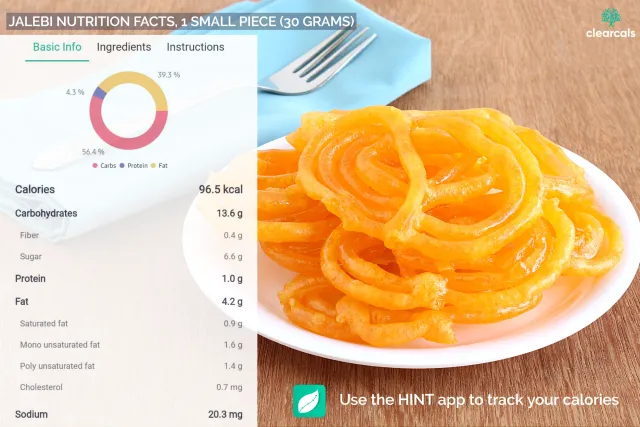
2. Jalebi Calories
One small piece (30 grams) of jalebi has 97 kcal. 56% of these calories are from carbohydrates, 4% from protein, and 40% from fat. Whereas 100 grams of jalebi has 370 kcal. Jalebi is a deep-fried dessert made with refined carbohydrates.
It’s important to note that Jalebi has no essential nutrients, and its high sugar and fat content makes it something to enjoy sparingly. The Hint app can alert you when you're approaching your daily sugar limit.
Here is a table of how calories increase with the serving size of jalebi.
| Jalebi Size (in grams) | Calories (kcal) | |||
|---|---|---|---|---|
| 1 Jalebi | 2 Jalebi | 3 Jalebi | 4 Jalebi | |
| 1 Small piece (30 grams) | 97 | 194 | 291 | 388 |
| 1 Medium piece (40 grams) | 129 | 258 | 387 | 516 |
| 1 Large piece (50 grams) | 160 | 320 | 480 | 640 |
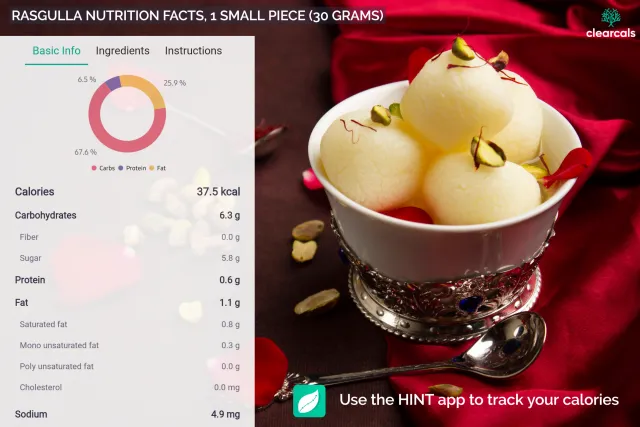
3. Rasgulla Calories
Rasgulla, a syrupy delicacy, is one of the lighter options in terms of calorie count. A small piece (30 grams) contains 38 kcal, making it a relatively low-calorie option among Indian sweets.
68% of these calories are from carbohydrates, 7% from protein, and 26% from fat. Whereas 100 grams of rasgulla has 130 kcal.
Still, it’s essential to moderate consumption due to its high sugar content. By using the Hint app, you can ensure that even these "lighter" sweets fit into your daily nutrition goals.
Here is a table of how calories increase with the serving size of Rasgulla.
| Rasgulla Size (in grams) | Calories (kcal) | |||
|---|---|---|---|---|
| 1 Rasgulla | 2 Rasgulla | 3 Rasgulla | 4 Rasgulla | |
| 1 Small piece (30 grams) | 38 | 76 | 114 | 152 |
| 1 Medium piece (40 grams) | 50 | 100 | 150 | 200 |
| 1 Large piece (50 grams) | 63 | 126 | 189 | 252 |
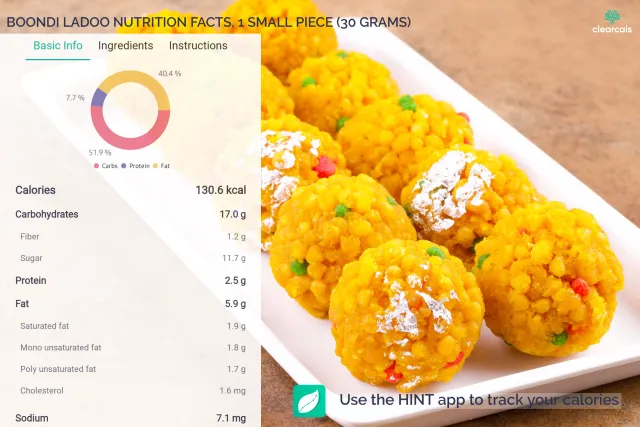
4. Boondi Ladoo Calories
Boondi Ladoo contains 131 kcal per small piece (30 grams), making it one of the higher-calorie sweets on this list. With the Hint app, you can manage your portions and ensure that your sweet cravings don’t derail your health goals.
The app allows Hint Pro users to adjust calorie targets for muscle gain or weight loss, making it easier to indulge mindfully.
Here is a table of how calories increase with the serving size of boondi ladoo.
| Boondi ladoo Size (in grams) | Calories (kcal) | |||
|---|---|---|---|---|
| 1 Boondi ladoo | 2 Boondi ladoo | 3 Boondi ladoo | 4 Boondi ladoo | |
| 1 Small piece (30 grams) | 131 | 262 | 393 | 524 |
| 1 Medium piece (40 grams) | 174 | 348 | 522 | 696 |
| 1 Large piece (50 grams) | 218 | 436 | 654 | 872 |
Here is a list of varieties of ladoo along with their calories. Download the Hint app to track the number of calories consumed from any of these ladoo varieties.
| Ladoo varieties | Calories (kcal) in 1 small piece (30g) |
|---|---|
| Murmura ladoo | 81 |
| Rajgira ladoo | 95 |
| Ragi oats ladoo | 107 |
| Ragi ladoo | 122 |
| Til ladoo | 126 |
| Boondi ladoo | 131 |
| Coconut ladoo | 132 |
| Moong dal ladoo | 132 |
| Besan ladoo | 141 |
| Dry fruits ladoo | 152 |
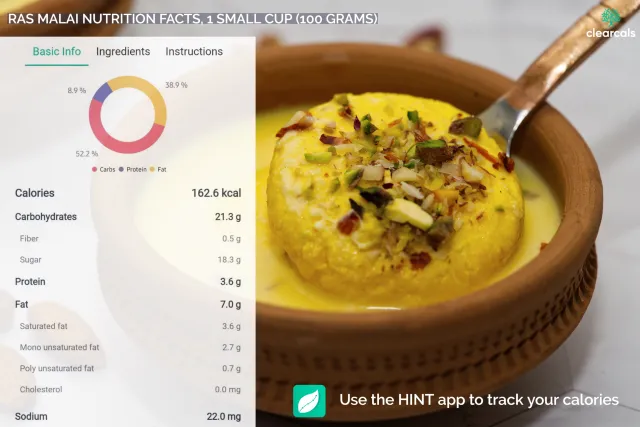
5. Rasmalai Calories
One small cup (100 grams) of Rasmalai has 163 kcal. 52% of these calories are from carbohydrates, 9% from protein, and 39% from fat. Rasmalai is a good source of vitamin E. Eat this dessert in moderation as it contains high sugar.
Here is a table of how calories increase with the serving size of ras malai.
| Ras Malai Serving Size (in grams) | Calories (kcal) |
|---|---|
| 1 Small cup (100 grams) | 163 |
| 1 Medium cup (200 grams) | 325 |
| 1 Large cup (300 grams) | 488 |
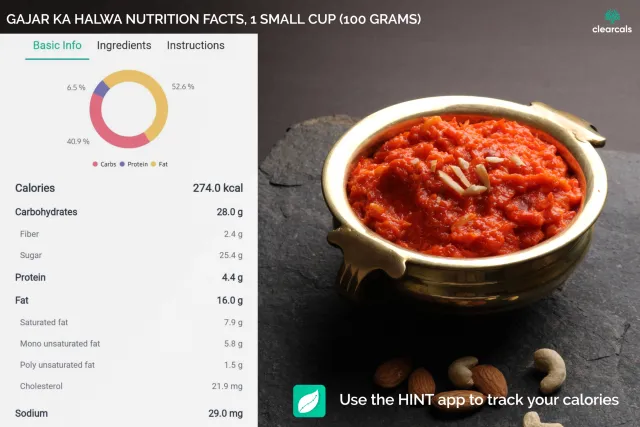
6. Halwa Calories
One small cup (100 grams) of Gajar ka halwa has 274 kcal. 41% of these calories are from carbohydrates, 7% from protein, and 53% from fat.
Gajar ka halwa is a good source of calcium, phosphorus, copper, selenium, manganese, and biotin, and an excellent source of alpha-carotene, beta-carotene, and vitamin E. Eat this dessert in moderation as it contains high sugar and saturated fat.
Here is a table of how calories increase with the serving size of Gajar ka halwa.
| Gajar ka halwa Serving Size (in grams) | Calories (kcal) |
|---|---|
| 1 Small cup (100 grams) | 274 |
| 1 Medium cup (200 grams) | 548 |
| 1 Large cup (300 grams) | 822 |
Here is a list of varieties of Halwa along with their calories
| Halwa varieties | Calories (kcal) in 1 Small Cup (100g) |
|---|---|
| Lauki ka halwa | 174 |
| Pumpkin halwa | 178 |
| Beetroot halwa | 183 |
| Gajar ka halwa | 274 |
| Wheat halwa | 281 |
| Ragi halwa | 282 |
| Sooji ka halwa | 301 |
| Chana dal halwa | 328 |
| Moong dal halwa | 332 |
| Dry fruits halwa | 499 |
| Badam ka halwa | 503 |
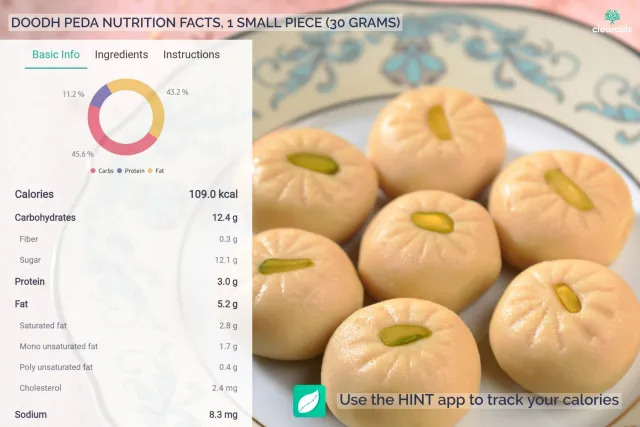
7. Peda Calories
One small piece (30 grams) of Doodh peda has 109 kcal. 46% of these calories are from carbohydrates, 11% from protein, and 43% from fat. Whereas 100 grams of Doodh peda has 360 kcal. Doodh peda is a good source of biotin, calcium, and selenium. Eat it in moderation as it is high in calories, sugars, and fats. Here is a table of how calories increase with the serving size of Doodh peda.
| Doodh peda Size (in grams) | Calories (kcal) | |||
|---|---|---|---|---|
| 1 Doodh peda | 2 Doodh peda | 3 Doodh peda | 4 Doodh peda | |
| 1 Small piece (30 grams) | 109 | 218 | 327 | 436 |
| 1 Medium piece (40 grams) | 145 | 290 | 435 | 580 |
| 1 Large piece (50 grams) | 182 | 364 | 546 | 728 |
Download the Hint app to track the number of calories consumed from doodh peda.
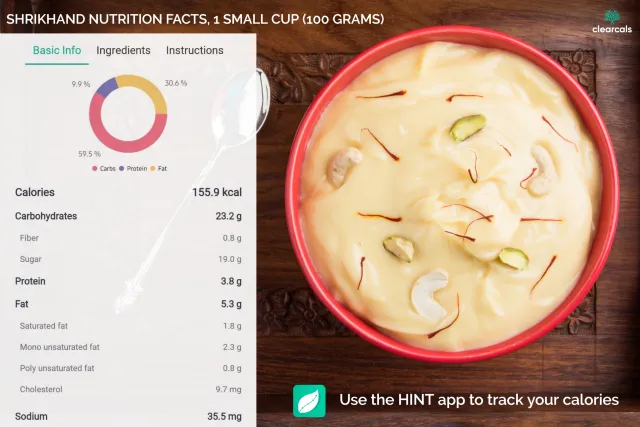
8. Shrikhand Calories
One small cup (100 grams) of Shrikhand has 156 kcal. 60% of these calories are from carbohydrates, 10% from protein, and 30% from fat. Shrikhand is a good source of calcium, phosphorus, vitamin B12, probiotics, and vitamin E. Eat this dessert in moderation as it contains high sugar.
Here is a table of how calories increase with the serving size of Shrikhand
| Shrikhand Serving Size (in grams) | Calories (kcal) |
|---|---|
| 1 Small cup (100 grams) | 159 |
| 1 Medium cup (200 grams) | 312 |
| 1 Large cup (300 grams) | 468 |
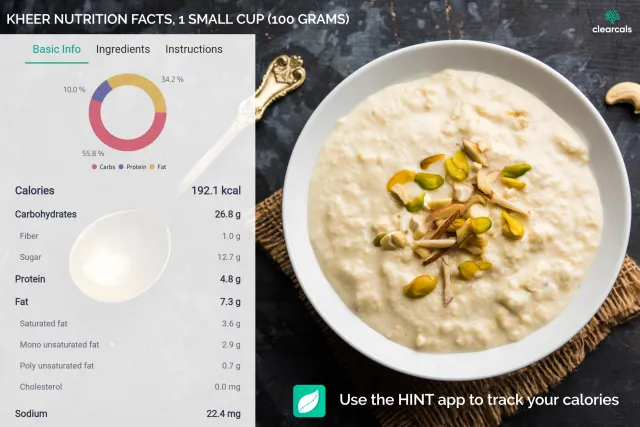
9. Kheer calories
One small cup (100 grams) of Kheer has 192 kcal. 56% of these calories are from carbohydrates, 10% from protein, and 34% from fat. Kheer is a good source of vitamin D, phosphorus, manganese, and vitamin E. Eat this dessert in moderation as it contains high sugar. Here is a table of how calories increase with the serving size of kheer
| Kheer Serving Size (in grams) | Calories (kcal) |
|---|---|
| 1 Small cup (100 grams) | 192 |
| 1 Medium cup (200 grams) | 384 |
| 1 Large cup (300 grams) | 576 |
Here is a list of varieties of Kheer along with their calories.
| Kheer varieties | Calories (kcal) in 1 small cup (100g) |
|---|---|
| Kheer | 192 |
| Sabudana kheer | 194 |
| Paneer kheer | 215 |
| Kaddu ki kheer | 221 |
| Dates kheer | 222 |
| Vermicelli kheer | 272 |
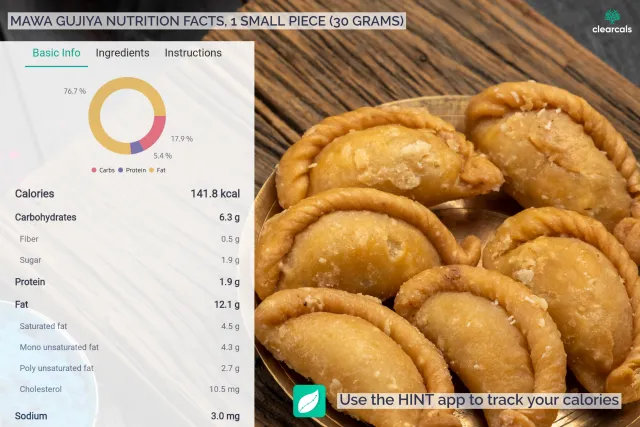
10. Gujiya calories
One small piece (30 grams) of Mawa gujiya has 142 kcal. 18% of these calories are from carbohydrates, 5% from protein, and 77% from fat. Whereas 100 grams of mawa gujiya has 473 kcal.
Mawa gujiya is a good source of selenium and an excellent source of vitamin E. Eat this dessert in moderation as it is high in calories and fat.
Here is a table of how calories increase with the serving size of Mawa gujiya.
| Mawa gujiya Size (in grams) | Calories (kcal) | |||
|---|---|---|---|---|
| 1 Gujiya | 2 Gujiya | 3 Gujiya | 4 Gujiya | |
| 1 Small piece (30 grams) | 142 | 284 | 426 | 568 |
| 1 Medium piece (40 grams) | 189 | 378 | 567 | 756 |
| 1 Large piece (50 grams) | 236 | 472 | 708 | 944 |
Download the Hint app to track the number of calories consumed from Mawa gujiya.
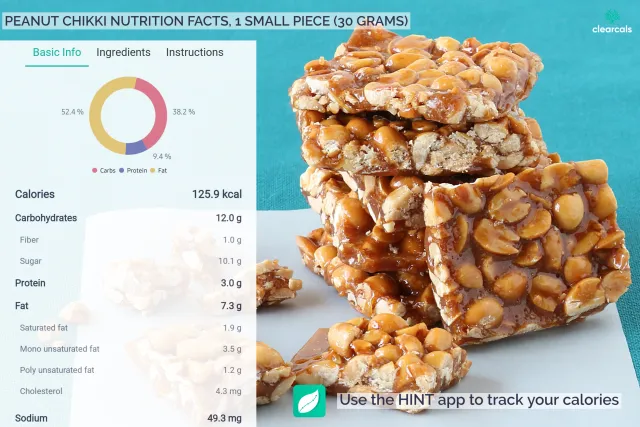
11. Peanut Chikki Calories
One small piece (30 grams) of peanut chikki has 126 kcal. 38% of these calories are from carbohydrates, % from protein, and 52% from fat. Whereas 100 grams of peanut chikki has 420 kcal.
Peanuts are abundant in protein, healthy fats, and dietary fiber and immensely rich in potassium, calcium, phosphorus, and B vitamins which offer a host of health benefits.
Healthy fats, proteins, and fiber curb appetite, lower the risk of heart disease, and regulate blood glucose levels.
Here is a table of how calories increase with the serving size of peanut chikki.
| Peanut Chikki Size (in grams) | Calories (kcal) | |||
|---|---|---|---|---|
| 1 Peanut chikki | 2 Peanut chikki | 3 Peanut chikki | 4 Peanut chikki | |
| 1 Small piece (30 grams) | 126 | 252 | 378 | 504 |
| 1 Medium piece (40 grams) | 168 | 336 | 504 | 672 |
| 1 Large piece (50 grams) | 210 | 420 | 629 | 839 |
| Chikki varieties | Calories (kcal) in 1 small piece (30g) |
|---|---|
| Til or sesame chikki | 123 |
| Peanut chikki | 126 |
Download the Hint app to track the number of calories consumed from chikki.
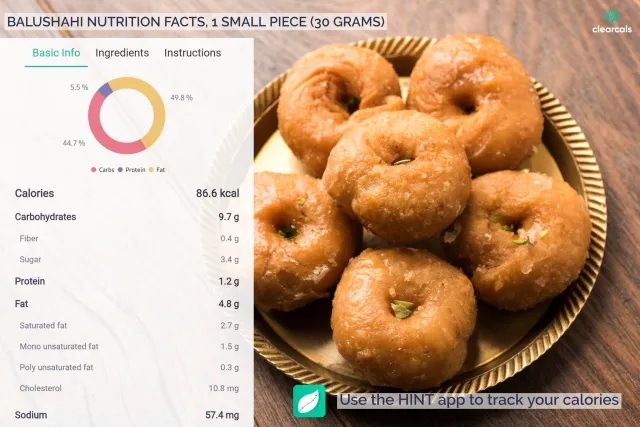
12. Balushahi calories
One small piece (30 grams) of Balushahi has 87 kcal. 45% of these calories are from carbohydrates, 5% from protein, and 50% from fat. Whereas 100 grams of Balushahi has 289 kcal.
Balushahi is a deep-fried dessert made with refined carbohydrates. Do not eat this dessert as it contains no essential nutrients and is high in saturated fat.
Here is a table of how calories increase with the serving size of Balushahi.
| Balushahi Size (in grams) | Calories (kcal) | |||
|---|---|---|---|---|
| 1 Balushahi | 2 Balushahi | 3 Balushahi | 4 Balushahi | |
| 1 Small piece (30 grams) | 87 | 173 | 260 | 346 |
| 1 Medium piece (40 grams) | 115 | 231 | 346 | 462 |
| 1 Large piece (50 grams) | 144 | 288 | 433 | 578 |
Download the Hint app to track the number of calories consumed from Balushahi.
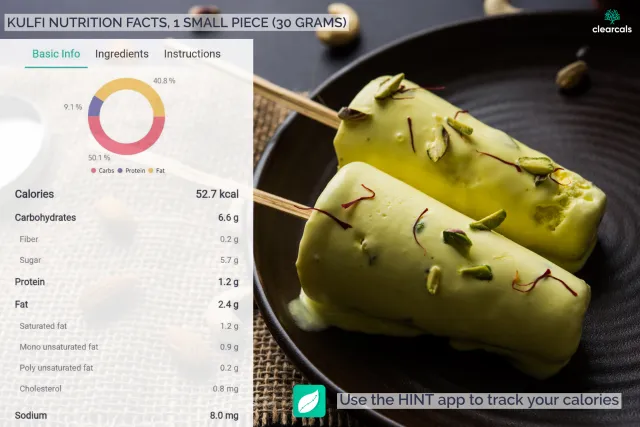
13. Kulfi calories
One small piece (30 grams) of Kulfi has 53 kcal. 50% of these calories are from carbohydrates, 9% from protein, and 41% from fat. Whereas 100 grams of kulfi has 176 kcal. Kulfi is a dessert high in calories and fats. Eat this in moderation as it is high in calories, sugar, and saturated fats.
Here is a table of how calories increase with the serving size of Kulfi.
| Kulfi Size (in grams) | Calories (kcal) | |||
|---|---|---|---|---|
| 1 Kulfi | 2 Kulfi | 3 Kulfi | 4 Kulfi | |
| 1 Small piece (30 grams) | 53 | 105 | 158 | 211 |
| 1 Medium piece (40 grams) | 70 | 140 | 211 | 281 |
| 1 Large piece (50 grams) | 88 | 176 | 264 | 352 |
Download the Hint app to track the number of calories consumed from Kulfi.
Are Sweets Good for Weight Loss, Diabetes, or Overall Health?
Sweets, by nature, are high in sugar and saturated fats, which can make achieving your health goals more challenging. Here’s what you need to know about sweets and various health conditions:
- Weight Loss: Most sweets are calorie-dense, and their high sugar content can lead to weight gain if consumed in excess. The Hint app helps you stay on top of your calorie intake to ensure that you indulge mindfully.
- Diabetes: Indian sweets typically have a high glycemic index, meaning they can cause rapid spikes in blood sugar levels. Managing your sugar intake using the Hint app’s Diet Summary feature is a great way to monitor these spikes.
- Muscle Gain: Sugars don’t contribute to muscle gain, and too much sugar can even cause muscle inflammation. With the Pro Workouts feature on the Hint app, you can focus on muscle-building foods and track your workouts.
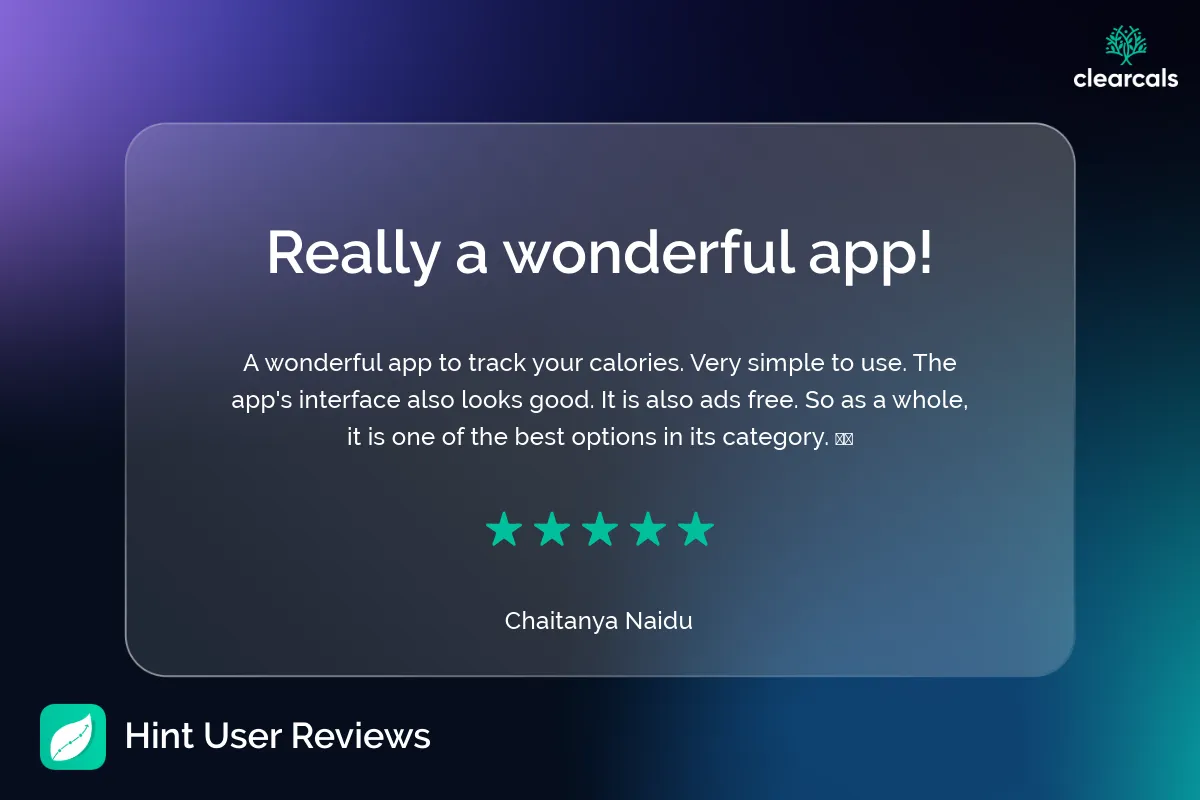
How Hint App Enhances Your Nutrition Tracking
Tracking your calorie intake and staying on top of your nutritional goals becomes effortless with the Hint app.
Whether you’re a Hint Pro subscriber using the Edit Goals feature to adjust your intake or a Hint Premium user benefiting from unlimited dietitian support, the app helps you maintain control over your diet. Here are just a few features to help you on your journey:
- Personalized Calorie and Macronutrient Goals: Tailor your diet to fit your specific needs, whether you’re aiming for weight loss, muscle gain, or managing conditions like diabetes.
- Instant Diet Plans: Get customized meal plans based on your goals, including options for weight management and health conditions.
- Pro Workouts: Track over 300 workouts to manage your calorie burn without the need for wearables.
- Add Your Own Recipe: Make it easier to track homemade sweets like Gulab Jamun by adding your recipes directly to the app.
Final Thoughts
Sweets like Gulab Jamun, Jalebi, and Kaju Katli can be a delightful part of your diet when consumed mindfully.
With the Hint app, tracking your calorie intake, managing macronutrients, and sticking to your health goals becomes simple and effective.
Whether you're indulging occasionally or adjusting your diet for muscle gain or diabetes management, the Hint Pro and Hint Premium subscriptions provide all the tools you need to stay on track.
For more information on Indian sweets, recipes, and nutrition facts, download the Hint app and take charge of your health journey today.
Exclusive Offer: Enjoy One Month of Free Hint Premium Access
When you purchase any of the following from the Clearcals Store: Garmin Venu Sq 2, Garmin Vivoactive 5, Garmin Instinct 2, Instinct 2X Solar, or Instinct 2X Solar Tactical, you'll receive one month of free Hint Premium (worth Rs. 1999), which includes:
✅ Unlimited dietitian consultations
✅ Personalized diet and workout plans
✅ Advanced calorie and nutrition tracking
🚀 Visit the Clearcals Store today and unlock your free Hint Premium access!





